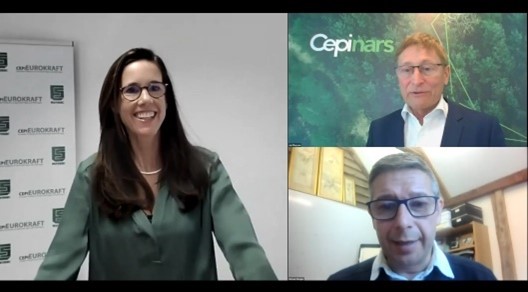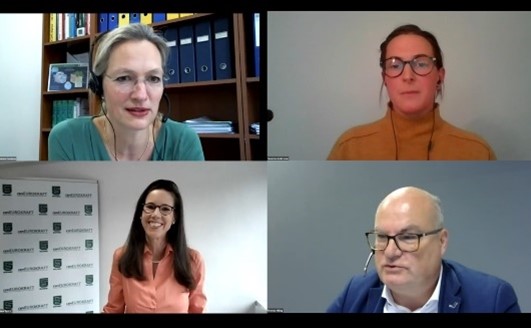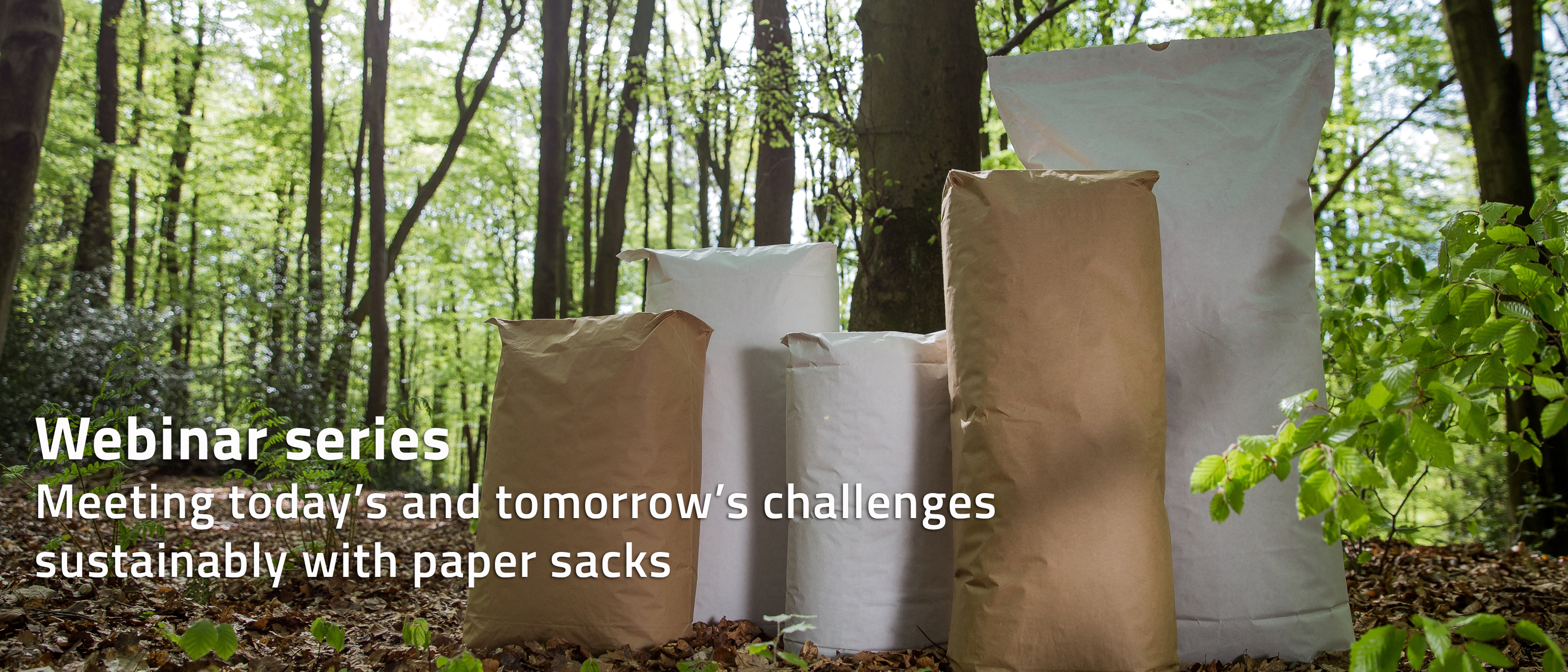The first part of the webinar series, “The role of paper packaging in a circular bioeconomy”, discussed the importance of sustainable forest management and biobased materials such as paper for closing the loop and reducing emissions.

Moderator Corinna Egerer with Jori Ringman and Michael Sturges
Sustainable at heart: European paper industry
Jori Ringman, Director General at Cepi, gave the bigger picture by presenting the achievements of the European paper industry and explaining how it can support other industries in achieving their sustainability targets. “We have a long track record of sustainability,” Ringman said. “Making sure that the resource is there for future generations has been the core for our success.” The European paper industry operates in an industrial symbiotic ecosystem, where nothing is wasted. With a recycling rate of 73.9% in 2020, it is the world champion in recycling. Also, it uses the highest rate of certified materials (75%) and leads in sustainable sourcing: 67% of fibres come from the circular economy, 33% from forest management operations such as tree thinning, and wood rejected by sawmills. Moreover, Ringman stated that the sector is advanced compared to all other sectors in the reduction of CO2 emissions (–48% since 1990) and the use of bio-based energy (62%). Thanks to the key principle of harvesting less than is grown, forests in Europe grow by 612 million m3 per year – a volume large enough to fit the entire global population. As another major benefit of forest-based products, Ringman highlighted their potential to mitigate climate change – which can also help other industries in achieving carbon neutrality. One of the greatest challenges he sees in the set of policies around the European Green Deal: “When not done right, we could export pollution and import unemployment. We heavily invest in bioeconomy, and raise the bar even higher by setting ambitious targets for future improvements and supporting the Green Deal to be successful.”
Paper sacks – a sustainable packaging
Focusing on the key attributes for sustainable packaging addressed in legislation – bio-based and renewable, low-carbon, recyclable – Michael Sturges, Research Consultant from the Swedish research institute RISE, presented facts and figures on the sustainability credentials of paper sacks. “Paper sacks are predominantly manufactured from virgin fibres sourced from sustainably managed European forests,” he explained. The average European paper sack contains more than 90% bio-based material, and many solutions are 100% bio-based. Moreover, sack kraft paper production is very energy self-efficient: 77% of all energy needed is generated on-site. Of the fuels used, 89% are renewable. “The industry has continuously reduced the fossil carbon footprint of an average European paper sack,” Sturges pointed out. “From 2007 to 2018, it fell by 28%.” When including biogenic CO2 removals and emissions, the total carbon footprint would even be negative. “That means it has a positive impact on the climate, and demonstrates that paper sacks have a real role to play in the low-carbon economy,” said Sturges. In terms of recyclability, he explained that the long, virgin kraft paper fibres can be a valuable source in the recycling industry. As best practice example, he introduced the German collection and recycling scheme Repasack.

Catherine Plitzko-Kerninon and Susanna Andersson with moderator Corinna Egerer and Thomas Hilling
Paper sacks offer perfect product protection
As switching to a more sustainable packaging solution is only one side of the story, the second webinar “Paper sacks – sustainable packaging with high performance” centred around how paper sacks perform in terms of product protection, functionality and cost-efficiency. Catherine Plitzko-Kerninon, General Delegate at EUROSAC, explained why paper sacks provide strong product protection and high material efficiency. “The strength of sack kraft paper has been improved by 45% in the last two decades,” she illustrated. “Only 100 g of paper – the weight of a bar of chocolate – can hold 25 kg of material.” The strength results in high product protection and low damage rates. A study found that the damage rates of paper sacks are less than 1–2% from point of fill to point of sale. Most damage can be prevented by proper handling. EUROSAC and CEPI Eurokraft have published handling recommendations for the entire value chain. Another study she presented tested the shelf life of cement paper sacks compared to cement PE sacks in typical storage conditions for 18 months. The quality and performance of the packed cement were well within the requirements of the cement industry for both sack types. Moreover, paper sacks offer reliable protection against dampness and moisture. “Many sacks still use conventional fossil-based barriers to enhance product protection, for example against humidity,” said Plitzko-Kerninon. “Our target for the future is to manufacture paper sacks from 100% natural materials that offer the same functions while maintaining recyclability. Recent innovations from our industry show that we are on a very good way.”
Meeting compliance for food contact
Susanna Andersson, Project Manager at Normpack, shed light on another important aspect of sustainable packaging: consumer safety, specifically the safety of food contact materials (FCM). She explained how the safety of FCM is regulated within the EU: “The structure of the FCM legislation is very complex, even more so as different countries can set their own rules.” She presented the ESG guidelines for paper sacks in contact with food. The document proposes a structured way to handle food contact legislation and provides basic knowledge on existing legislations and recommendations. “FCM legislation is being revised by the European Commission right now,” indicated Andersson. “Hopefully, it will include material-specific legislation also for paper and board in the future – that would make compliance for food contact a lot easier.”
Efficiency benefits of paper sacks
Safety and efficiency aspects of paper valve sacks during filling and handling were discussed by Thomas Hilling, General Manager at Haver & Boecker Institute. “Thanks to the strength and porosity of sack kraft paper, paper sacks provide a clean, economic and very fast filling,” he stated. “Automatic sack application allows a performance up to 6,000 sacks per hour, with a precision of 99.97%.” Good permeability saves operation costs: the more permeable the sack kraft paper, the higher is the filling productivity and the stability of the sacks on the pallet. For more cleanliness, Thomas Hilling introduced the ultrasonic valve sealing technology: “It provides a tight and solid seal in less than one second.” He also emphasised the importance of the right sizing and gave examples of the benefits of perfectly sealed and filled sacks: higher weight accuracy, logistics efficiency, safe stacking and transportation, and perfect product appearance. For in-depth information, he referred to the industry guidelines for dust-free paper sacks by EUROSAC and CEPI Eurokraft. His conclusion: “With high performance paper valve sacks, the whole packaging process is efficient.”
Recordings of both webinars are available on the EUROSAC website.
For more information contact Catherine Plitzko-Kerninon: +33 (0)147 237 558, info[at]eurosac[dot]org.



